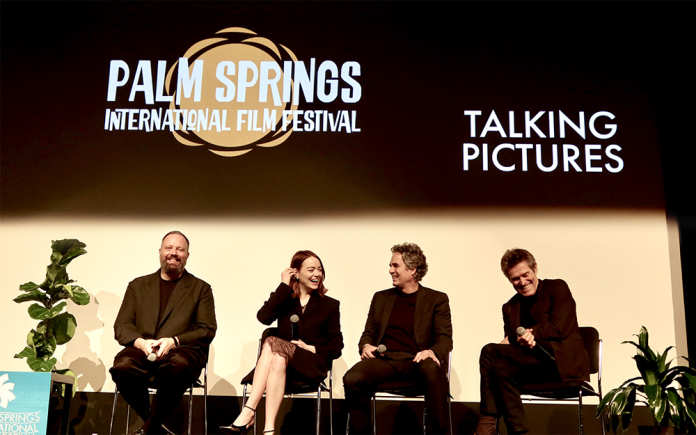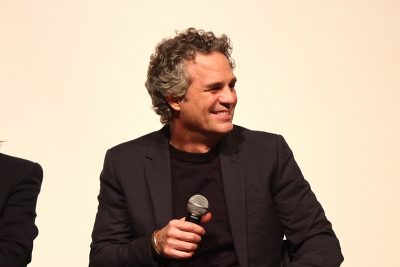
By Crystal Harrell
On January 5, the Palm Springs International Film Festival presented a Talking Pictures screening of director Yorgos Lanthimos’ science fiction black comedy, Poor Things, at the Annenberg Theater in the Palm Springs Art Museum. The plot follows a young woman (played by Emma Stone) who is brought back to life by the brilliant and unorthodox scientist Dr. Godwin Baxter (played by Willem Dafoe), and runs off with a slick, debauched lawyer (played by Mark Ruffalo) on a whirlwind adventure across the continents.
 Lanthimos attended the presentation, in addition to Stone, Dafoe, and Ruffalo to take part in a star-studded panel following the screening of the film. The panel discussed the working relationship between Stone and Lanthimos—with her role as Bella Baxter in Poor Things being developed while filming The Favourite together in 2018. Lanthimos began developing Poor Things more actively following the success of The Favourite.
Lanthimos attended the presentation, in addition to Stone, Dafoe, and Ruffalo to take part in a star-studded panel following the screening of the film. The panel discussed the working relationship between Stone and Lanthimos—with her role as Bella Baxter in Poor Things being developed while filming The Favourite together in 2018. Lanthimos began developing Poor Things more actively following the success of The Favourite.
“The role made sense to me because she is very human. I think the idea of playing a woman who gets to start from scratch and has this metaphoric, kind of dark fairytale that can’t actually happen, it was such a fascinating kind of exploration of what it is to be alive. I was in love from the beginning,” shared Stone.
 “Their comfort with each other just made it safe for a collaborative environment. It’s very safe. It’s very kind. They are two artists who trust each other to the depth that they do and are as intimate as they are, so it was heartwarming,” added Mark Ruffalo, about working alongside Stone and Lanthimos’ established connection.
“Their comfort with each other just made it safe for a collaborative environment. It’s very safe. It’s very kind. They are two artists who trust each other to the depth that they do and are as intimate as they are, so it was heartwarming,” added Mark Ruffalo, about working alongside Stone and Lanthimos’ established connection.
Principal photography for Poor Things took place in Hungary, beginning in August 2021 at Origo Studios in Budapest and wrapping in December of that year. Lanthimos worked with cinematographer Robbie Ryan, and cited that Francis Ford Coppola’s Bram Stoker’s Dracula served as the main source of inspiration for everyone making the picture and the one movie that was referred to more than most.
 “We prepare a film language and come up with certain rules. We did a lot of testing before we started filming with lenses and film stocks and formats. When we narrowed it down and said we’re going to use these four lenses and we’re going to shoot this part of the film in black and white and this part of the film in color chrome, there were these ideas we wanted to try. We agree on certain things, but we don’t prepare scene by scene beforehand. We have our rules, we have our language, we have our tools and then on the day, we rehearse or see the actors in the space and then decide how we want to film,” explained Lanthimos.
“We prepare a film language and come up with certain rules. We did a lot of testing before we started filming with lenses and film stocks and formats. When we narrowed it down and said we’re going to use these four lenses and we’re going to shoot this part of the film in black and white and this part of the film in color chrome, there were these ideas we wanted to try. We agree on certain things, but we don’t prepare scene by scene beforehand. We have our rules, we have our language, we have our tools and then on the day, we rehearse or see the actors in the space and then decide how we want to film,” explained Lanthimos.
It was also revealed that Dafoe attended mortician school. “I worked with a woman that worked at the morgue and I learned how to cut and sew and do autopsy things. You don’t really see much of that in the movie. It’s just for fun,” joked Dafoe about the graphic medical sequences depicted in the film.
 Dafoe spent six hours each day in the hair and makeup department–four hours getting extensive prosthetics applied to his face at the start of the day and two hours to get it all taken off at the end of the day.
Dafoe spent six hours each day in the hair and makeup department–four hours getting extensive prosthetics applied to his face at the start of the day and two hours to get it all taken off at the end of the day.
Reflecting on the experimental theater games Lanthimos assigned the cast prior to filming, Dafoe shared, “You’re very patient with everyone, and everyone’s patient with you. They need to be confident in what they’re doing because what we’re doing is quite risky. It’s not a normal film.”
Discussing the male characterizations, Lanthimos acknowledged that while each male character was different and had their own individual motivations, they each represented male attitudes typical of the story’s Victorian setting. The theater games made to enhance the actors’ perspectives helped the filming process.
“All of that was inside of us and how we related to each other–how much comfort we had with each other, how much trust we had with each other, and then how we communicated with each other. What that kind of rehearsal does is it takes you out of your head. We didn’t talk. There was no talk about the characters. We knew what the script was and that was a seed that was planted in us the whole time, and so it was informing all the work we were doing,” shared Ruffalo.
Poor Things is now playing in theaters worldwide.












































